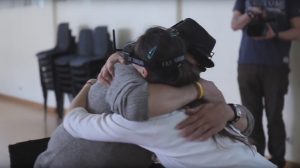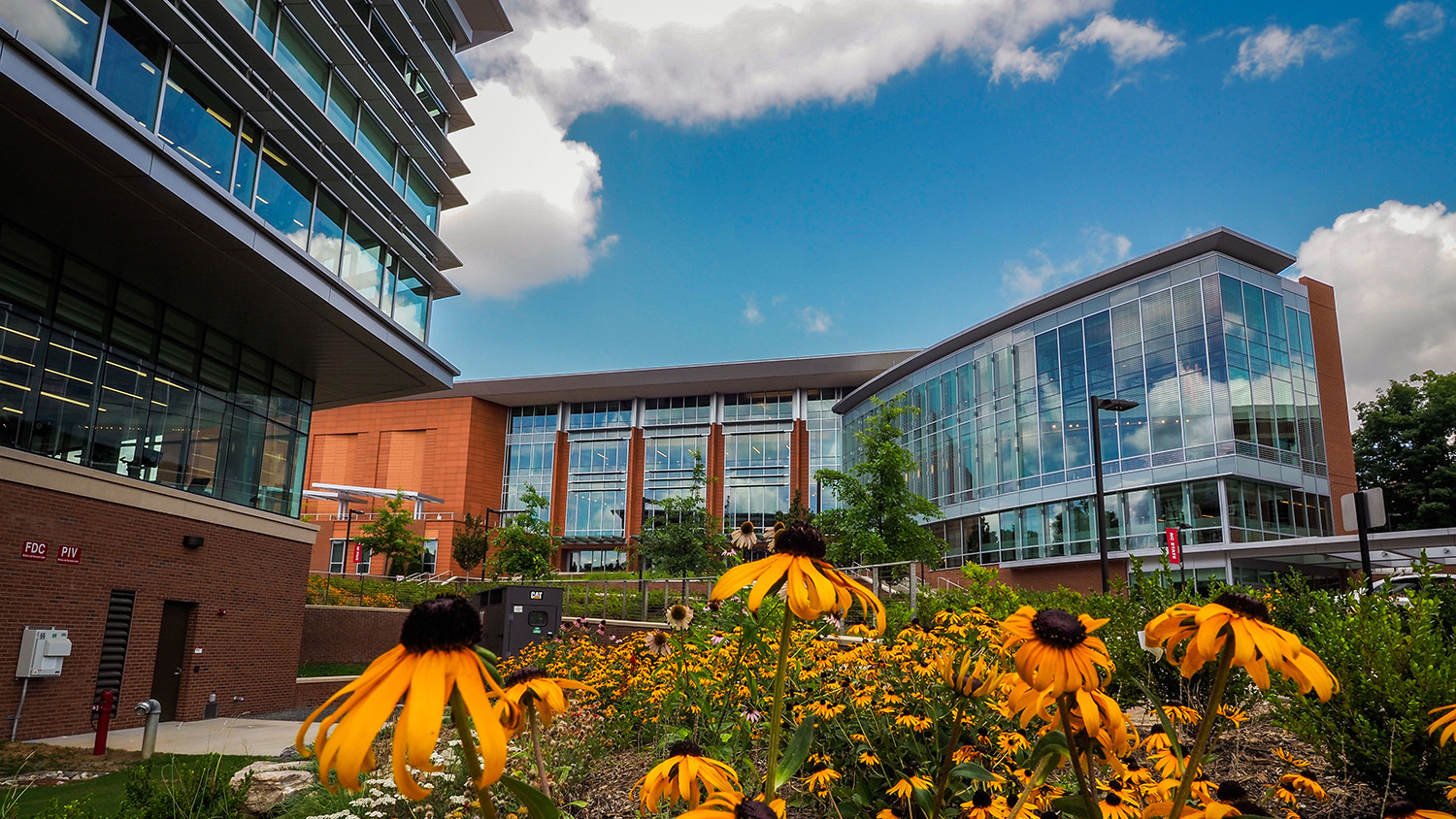East Coast Game Conference 2017 Recap

The East Coast Game Conference (ECGC) is a weekend dedicated to collaboration and networking among video game professionals. Participation ranges from academic to industry professionals all sharing tips and tricks of the trade.
At the 2017 conference held April 18-20 at the Raleigh Convention Center, DELTA staff members from New Media Development, Instructional Design and others interested in game design, development and virtual reality attended various sessions.
DELTA staff in partnership with the Global Training Initiative hosted a virtual reality exhibit in the VR Village showcasing a cultural competency training module facilitated by the DELTA Grants Program.
Below attendees from DELTA share their takeaways and highlights from the conference.
Session: All the World’s a Stage: Applying Live Action Roleplaying Design Principles to Augmented Reality Games – Heather Albano
Live action role-playing (LARP) games were a small but memorable part of my teens (and I’ll admit it…early twenties). So, I was particularly excited to attend Heather Albano’s session, “All the World’s a Stage: Applying Live Action Roleplaying Design Principles to Augmented Reality Games” at ECGC.
I’ve always loved that LARP is such an immersive gaming experience (sometimes involving cardboard armor and foam swords), limited only by the players’ imaginations and physical surroundings. For example, the multipurpose rooms at our local Boys & Girls Club became dungeon chambers, and the woods behind the elementary school transformed into an enchanted forest.
At Albano’s session, it was interesting to hear how AR game designers took a page from the LARP handbook and found clever ways to use AR technology’s inherent limitations to enhance the overall gaming experience. For example, the AR game CodeRunner (best played in large public spaces) uses GPS on participants’ devices to help create missions set in player’s’ own cities and towns.

Similarly, Albano explained, educational mobile phone game Frequency 1550, which was created for middle school students in Amsterdam, teaches pupils about the Middle Ages by sending them on quests throughout the city. The game has been considered a huge success, and it was found that students who played the game retained more information than students taught using classic methods.
Another interesting limitation of AR is the fact that, during many AR experiences, images on a device’s screen can interact with the user’s surroundings in strange ways (as anyone who’s played Pokemon Go can attest). In-game characters or graphics can look as though they are floating or perhaps passing through real-world objects. Albano said some developers used this quirk to their advantage by creating haunted house tours and other games involving ghosts since ghosts traditionally behave like those floating, otherworldly AR visuals.
Overall, the presentation was a great reminder that playing to your (or your technology’s) strengths and acknowledging (or even embracing) your weaknesses can pay off. Also, now that live action role-playing and augmented reality have joined forces, it might be time to dust off that cardboard armor.
Session: From Mobile to VR – Enrique Fuentes
VR was definitely a hot topic for this conference. One of the sessions that really stood out for me was “From Mobile to VR” by Enrique Fuentes of Teravision Games. He spoke of his company’s experience with first trying to get a VR game to market quickly (and the shortcomings of that) and then how they learned from that first attempt and used it to produce a far better experience in producing their second VR game, Neon Fury.
One of the more interesting observations Enrique made was around the challenges of having a UI in a VR environment. Typically in games and other interactive applications, there are persistent UI elements where information is displayed, but that doesn’t work as well in VR where the user can look anywhere. The solution that Teravision came up with was to have the information the player needed present in multiple locations in the environment (such as an ammo counter on their weapon, health of the tower locations being displayed on a system console in the environment, bulletin boards that displayed progress information, etc.).

Furthermore, they applied something that they learned from sporting events to their in-world UI: redundancy to how this information was displayed. They noticed that at sporting events information like the score, time remaining in the game and any other information was displayed simultaneously in several locations all around the field so that anyone in the audience (and the players themselves) had access to it no matter where they were facing. “Treat it like a sport. You need a redundancy of information so the athletes (and fans) can look at it and find the information from any angle.”
Some other key VR takeaways include:
- Include environmental elements that can help prevent disorientation if players can teleport from location to location. For example, a large building or sign that is visible from multiple positions will give a good sense of relative location.
- When developing in VR it is key to test in VR. The computer screen is not the same experience!
- Keep scope and efficiency to the point where everything that is included can be justified. Optimization is absolutely critical for creating immersive VR experiences.
- It is more important to create a good, intuitive, and immersive experience than to create one that can run on the broadest selection of platforms. A good player experience is critical to the success of the application.
Session: Ya feel me? How augmented and virtual reality can be used to foster attitude change, cultural competency, and empathy – Dr. Jennifer Elliott
I mostly assumed VR was being used for video games & entertainment – after all that’s what you hear about. But the “ya feel me” presentation helped broaden my views of what VR can be used for outside of pure entertainment. The speaker brought to light the hype of VR versus the actual value of VR — what can we do with VR that we couldn’t do without it?
Can we change behavior and attitude? What would happen if we were to embody another person – a different gender, race, age, economic background, etc? Would our feelings or perceptions towards that specific population change? An example of testing this theory is the BeAnotherLab, an open source art investigation that is an “interactive performance installation that allows users to interact with a piece of another person’s life story by seeing themselves in the body of this person and listening to his/her thoughts inside their mind.” This experiment is designed to promote empathy for others and change individual perceptions.

The key to creating empathy with VR is that the participants are both fully immersed and “embodied” into the VR world. If you lack the embodiment, the user will not walk away with empathy. Embodiment can be achieved by something as simple as having both the VR body and the actual person’s body arm touched at the same time. This tricks the brain into thinking the VR body is it’s actual body and so creates an embodiment experience. Once you have empathy via embodiment in VR experiences, it has so many possible applications: from medical professionals embodying their patients to help treat bias to police embodying members of the public to develop empathy. It could be used with the military to help treat PTSD, as well as with pre-service teachers to help them empathize with their disabled students. It’s not just about making really cool games – it can become a mechanism for change.
Session: Designing A Department: Incubating Designers With Hard Work & Play- Harley Baldwin
One of the most pleasantly surprising sessions for me was “Designing A Department: Incubating Designers With Hard Work & Play” with Harley Baldwin, Vice President of Game Design for Schell Games. While she didn’t focus on a specific game or design/development challenge, Harley described the many challenges present in leading and coordinating a large team of designers and shared her biggest lessons learned in keeping her designers happy, productive and developing!
The two biggest takeaways for me were on “making department meetings not suck” and effectively distributing leadership.

Harley described how department meetings started out feeling like a waste of time to attendees, and how she broke these large meetings down into multiple types, based on team needs and feedback from employees. While I kind of nerded out in seeing the breakdown of all the types of meetings, who they involved, and their annual frequency, I’ll spare you the details and share the two coolest ones:
Designer Playdate
A designer is in charge of coordinating this meeting, asking others what they have to show. Those with things to share get other designers to play with what they’ve created, discussing mechanics and prompting questions. Sounds like a good ol’ fashion show ‘n tell, except with colleagues in the room who can give expert feedback.
Game Design Game
A designer designs a game that teaches other designers about game design. Like, whoa. After taking a minute for that to set in, it sounded to me like an ingenious way to use games and gameplay (or any interactive media) as a medium for teaching and exchanging complex ideas. One caveat was that while this was immensely popular, it also took a long time to set up. Go figure…
To go along with meeting revamping, Harley shared strategies for reducing the overwhelming demands of heading a large team by distributing leadership:
- Figure out ways to use experts efficiently within a team
- Encourage team members to conduct a roundtable or shareout to help build leadership skills
- Encourage the team to seek out mastery in different things
- Encourage mentorships
Overall, I left this session feeling charged up, seeing how large teams and organizations can improve their workplace and give employees in all places the chance to shine and grow!
Session: Living With a Passion and Purpose: How to “Be Authenticatious!” – Gina Grahame
Between “Gamifying Cinematic Animation Production” and “Augmented and Virtual Reality” there were a few sessions focused on motivation and working with passion. While I learned a lot from the game oriented classes, I got a lot out of the motivational track as well.
This session was lead by Gina Grahame, an international award winning speaker and expert on Authentic Communication, the soft skills of business. During this session, we discussed making assumptions about others. The associated exercise was to sit with a fellow attendee and share your first thoughts and “assumptions” about him/her. I sat across from a young and outspoken young man who appeared very confident. After sharing our assumptions, he revealed that he pushes himself to overcome a stuttering challenge. It was a strong lesson to communicate without judgment and remain open while being true to yourself.
Gina related the skills discussed to her own development as a person, communicator and member of the transgender community. This direct connection to her own life really made this session stand out to me. Gina shared very personal stories and made herself vulnerable to the audience and made the topic of authentic communication really ring true.
- Categories:


